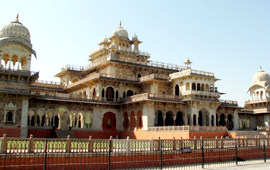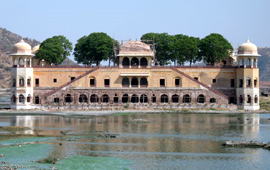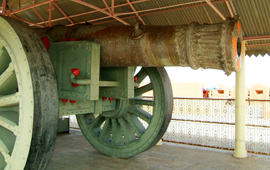
Albert Hall, Jaipur

Jal Mahal, Jaipur

Jaigarh Fort, Jaipur
Jaipur is only 262 km from Delhi, the capital of India and is well connected by rail, road and air. Popularly known as the Pink City, it was founded in 1727 AD by one of the greatest rulers of the Kachhawaha clan, the astronomer king Sawai Jai Singh. The pink color was used at the time of making to create an impression of red sandstone buildings of Mughal cities - and repainted in 1876, during the visit of the Prince of Wales. The city is best explored on foot and the adventurous visitor willing to go into the inner lanes can discover a whole new world not visible to the tourist-in-a-hurry.
Places of Interest:
Places of interest are mainly located within the walled city. The City Palace complex is the most important landmark with its numerous outbuildings, courtyards, impressive gateways and temples. Across the road from the palace is the Jantar Mantar, one of the five observatories built by Sawai Jai Singh. A collection of complex astronomical instruments, chiseled out of stone- most of which continue to provide fairly accurate information to this day - is the highlight of this observatory.
Hawa Mahal (Palace of Winds) adjoins the outside of the palace wall. Built in 1799 by Maharaja Sawai Pratap Singh, the Hawa Mahal is a remarkable structure which overlooks one of the main streets and also provides some excellent views of the city. In the not-too-distant past, ladies of the court found it convenient to watch the activities on the streets below without being observed themselves.
Located just outside the walled city is the sprawling Ram Niwas Garden. The garden houses the majestic Albert Hall Museum. Opened in 1887 AD, this impressive building displays a rich collection of paintings, carpets, ivory, stone and metal sculpture among other objects.
The Garland Forts:
These forts, though built at different periods, are so located that they seem to be stringed together
- Amer
Set in a picturesque location, Amer is a fascinating blend of Hindu and Mughal architecture. Built in the 16th century by Raja Man Singh, it sprawls on the hillside. Built in red sandstone and white marble, the palace complex has some very interesting apartments, the likes of which are not to be found anywhere else in the country. Jai Mandir, Sheesh Mahal, Sukh Niwas and Ganesh Pole are the prominent areas of interest.
The old township of Amer lies at the foothills of the palace and has an old world charm, a character of its own. Jagat Shiromani Temple, Narsingh Temple are some of the places of interest.
- Jaigarh
Jaigarh, or the Fort of Victory, is a rugged fort built in 1726. The world's largest cannon on wheels is to be found here. The fort houses a museum and provides some excellent views of the Amer Palace.
- Nahargarh
It is the first of the three forts. Built in 1734, this fort provides some stunning views of the city down below both during daytime and at night. An open air restaurant-"PADAO" lets you enjoy the panoramic view of the city even as you sip a hot cup of coffee on a pleasant evening.
Shopping:
Jaipur is a shopper's paradise. This is one of the few places where the shoppers may actually watch the skilled artisans producing the articles they want to buy. Jaipur is popular for block printing dresses and home linen, stones and pearls and a variety of handicrafts.